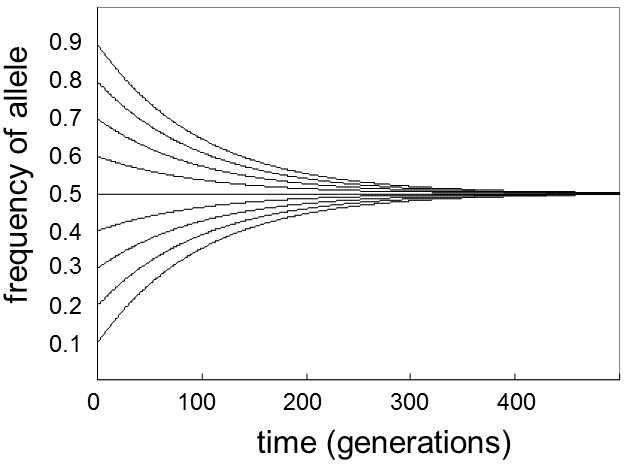VII.2.4 Gene flow reduces differences in the frequency of alleles between populations.
Individual subpopulations can differ in the representation of the various alleles in their gene pools. These differences can, for example, occur for historical reasons, where each subpopulation was established by a limited number of founders, while the representation of alleles in the population of the founders may be very different from their representation in the gene pool of the species. Gene flow tends to gradually eliminate the differences in the representation of alleles. If a particular allele appears withp0 frequency in the subpopulation and with P frequency in the gene pool of the whole metapopulation and if, because of the structure of the metapopulation and the nature of migration, migrants from all the other subpopulations are equally likely to reach this subpopulation then, in the course of one generation, the frequency of the given allele will change from p0 to p1:
p1 = p0 (1-m) + mP = p0- mp0+mP = p0- m (p0-P),
where m is the intensity of the gene flow, namely the fraction of those copies of a given allele in the subpopulation that were introduced via migration within one generation. Thus the change in frequency
Δp = m (p0 - P )
attains the value pn after n generations, where
pn= (1 - m)n(p0-P) + P
The gene flow thus acts to gradually reduce the differences in allele frequency between subpopulations and, if no other evolutionary mechanisms act in the opposite direction, such as selection, drift, evolutionary drives or mutations, the frequencies would ultimately be the same in the whole metapopulation (Fig. VII.4).

Fig. VII.4 Allele frequency in a subpopulation is restored to the population-wide average. The frequency of the observed allele in the metapopulation is 0.5, its frequencies in the partial subpopulations vary from 0.1 to 0.9 at time t = 0. The chart depicts the dynamics of the frequencies in the subpopulations becoming equilibrated with the population-wide average. The model assumes that the share of migrants in each generation represents 1 % of the size of the subpopulation and that the subpopulations are of the same size and small compared to the size of the metapopulation.
